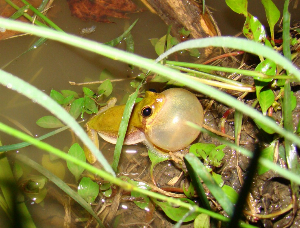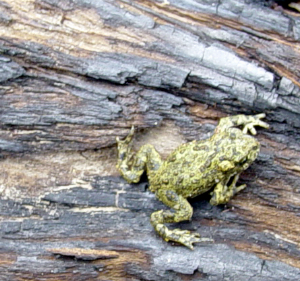Search ARMI Database
Search term(s)
Contribution Number
Search Results
857 record(s) found.
Papers & Reports Exploring sensitivity of a multistate occupancy model to inform management decisions
Authors: Adam W Green; Larissa L Bailey; J D Nichols
Outlet: Journal of Applied Ecology
Papers & Reports Habitat Use and Movement of the Endangered Arroyo Toad (Anaxyrus californicus) in Coastal Southern California
Authors: M J Mitrovich; Elizabeth A Gallegos; L M Lyren; Robert E Lovich; Robert N Fisher
Date: 2011 | Outlet: Journal of Herpetology 45: 9-12
Information on the habitat use and movement patterns of Arroyo Toads (Anaxyrus californicus) is limited. The temporal and spatial characteristics of terrestrial habitat use, especially as it relates to upland use in coastal areas of the species’ range, are poorly understood. We present analyses of radio-telemetry data from 40 individual adult toads tracked at a single site in coastal southern California from March through November of 2004. We quantify adult Arroyo Toad habitat use and movements and interpret results in the context of their life history. We show concentrated activity by both male and female toads along stream terraces during and after breeding, and, although our fall sample size is low, the continued presence of adult toads in the floodplain through the late-fall. Adult toads used open sandy flats with sparse vegetation. Home range size and movement frequency varied as a function of body mass. Observed spatial patterns of movement and habitat use both during and outside of the breeding period as well as available climatological data suggests overwintering of toads in floodplain habitats of near-coastal areas of southern California may be more common than previously considered. If adult toads are not migrating out of the floodplain at the close of the breeding season but instead overwinter on stream terraces in near-coastal areas, then current management practices that assume toad absence from floodplain habitats may be leaving adult toads over-wintering on stream terraces vulnerable to human disturbance during a time of year when Arroyo Toad mortality is potentially highest.
Papers & Reports Mitigating amphibian disease: strategies to maintain wild populations
Authors: Douglas C Woodhams; Jaime Bosch; Cheryl J Briggs; S Cashins; L R Davis; A Lauer; Erin Muths; R Puschenforf; Benedikt R Schmidt; B Sheafor; J Voyles
Date: 2011 | Outlet: Frontiers in Zoology
We assess existing disease mitigation strategies, some in early experimental stages, which focus on the globally emerging chytrid fungus Batrachochytrium dendrobatidis with the view that disease mitigation is an essential component of population management. We discuss the precedent for each strategy in systems ranging from agriculture to human medicine, and the outlook for each strategy in terms of research needs and long-term potential.
Papers & Reports Seeking a second opinion: uncertainty in disease ecology
Authors: Brett T McClintock; J D Nichols; Larissa L Bailey; Darryl I MacKenzie; W L Kendall; A B Franklin
Date: 2010 | Outlet: Ecology Letters 13: 659-674
Papers & Reports Dispersal and demographics on the american bullfrog of the semi-arid grassland
Authors: D O Suhre
Date: 2009 | Outlet: Thesis. Tucson: University of Arizona
Papers & Reports Urban Herpetology
Authors: J C Mitchell; B ro Jung; Breck Bartholomew
Date: 2008 | Outlet: Herpetological Conservation 3, Society for the Study of Amphibians and Reptiles. Utah: Salt Lake City
Papers & Reports Urban herpetology: global overview, synthesis, and future directions
Authors: J C Mitchell; B ro Jung
Date: 2008 | Outlet: p 1-30 in Mitchell JC, Jung Brown RE, Bartholomew B (editors). Urban Herpetology. Herpetological Conservation 3, Society for the Study of Amphibians and Reptiles. Utah: Salt Lake City
Papers & Reports Reproductive ecology and status of desert-breeding anurans at Saguaro National Park
Authors: S M Campbell
Date: 2008 | Outlet: Thesis. Tucson: University of Arizona
Papers & Reports Amphibians and Reptiles
Authors: P C Rosen; Cecil R Schwalbe
Date: 2007 | Outlet: Desert Plants 23:25-26
Papers & Reports Occurrence of Oral Deformities in Larval Anurans
Authors: D L Drake; Ronald Altig; J B Grace; Susan C Walls
Date: 2007-03-15 | Outlet: Copeia 2007: 449-458
We quantified deformities in the marginal papillae, tooth rows, and jaw sheaths of tadpoles from 13 population samples representing three families and 11 sites in the southeastern United States. Oral deformities were observed in all samples and in 13.5–98% of the specimens per sample. Batrachochytrium dendrobatidis (chytrid) infections were detected in three samples. There was high variability among samples in the pattern and number of discovered deformities. Pairwise associations between oral structures containing deformities were nonrandom for several populations, especially those with B. dendrobatidis infections or high total numbers of deformities. Comparisons of deformities among samples using multivariate analyses revealed that tadpole samples grouped together by family. Analyses of ordination indicated that three variables, the number of deformities, the number of significant associations among deformity types within populations, and whether populations were infected with B. dendrobatidis, were significantly correlated with the pattern of deformities. Our data indicate that the incidence of oral deformities can be high in natural populations and that phylogeny and B. dendrobatidis infection exert a strong influence on the occurrence and type of oral deformities in tadpoles.
Papers & Reports Diseases of amphibians
Authors: C L Densmore; David E Green
Date: 2007 | Outlet: ILAR Journal 48:335-356
Papers & Reports Habitat associations of chorusing anurans in the Lower Mississippi River Alluvial Valley
Authors: J S Lichtenberg; S L King; J B Grace; Susan C Walls
Date: 2006 | Outlet: Wetlands 26: 736-744
Amphibian populations have declined worldwide. To pursue conservation efforts adequately, land managers need more information concerning amphibian habitat requirements. To address this need, we examined relationships between anurans and habitat characteristics of wetlands in the Lower Mississippi River Alluvial Valley (LMAV). We surveyed chorusing anurans in 31 wetlands in 2000 and 28 wetlands in 2001, and measured microhabitat variables along the shoreline within the week following each survey. We recorded 12 species of anurans during our study. Species richness was significantly lower in 2000 than 2001 (t-test, P < 0.001) and correlated with an ongoing drought. We found species richness to be significantly greater at lake sites compared to impoundment, swale, and riverine sites (ANOVA, P = 0.002). We used stepwise regression to investigate the wetland types and microhabitat characteristics associated with species richness of chorusing anurans. Microhabitat characteristics associated with species richness included dense herbaceous vegetation and accumulated litter along the shoreline. Individual species showed species-specific habitat associations. The bronze frog, American bullfrog, and northern cricket frog were positively associated with lake sites (Fisher’s Exact Test, P < 0.05), however wetland type did not significantly influence any additional species. Using bivariate correlations, we found that six of the seven most common species had significant associations with microhabitat variables. Overall, our findings support the view that conservation and enhancement of amphibian communities in the LMAV and elsewhere requires a matrix of diverse wetland types and habitat conditions.
Papers & Reports Challenges in evaluating the impact of trade in amphibians and reptiles on wild populations
Authors: M A Schlaepfer; C Hoover; Kenneth C Dodd
Date: 2005 | Outlet: BioScience 55: 256-264
Papers & Reports Amphibian declines: the conservation status of United States species
Authors: Michael J Lannoo
Date: 2005 | Outlet: Berkeley: University of California Press
This benchmark volume documents in comprehensive detail a major environmental crisis: rapidly declining amphibian populations and the disturbing developmental problems that are increasingly prevalent within many amphibian species. Horror stories on this topic have been featured in the scientific and popular press over the past fifteen years, invariably asking what amphibian declines are telling us about the state of the environment. Are declines harbingers of devastated ecosystems or simply weird reflections of a peculiar amphibian world?
This compendium--presenting new data, reviews of current literature, and comprehensive species accounts--reinforces what scientists have begun to suspect, that amphibians are a lens through which the state of the environment can be viewed more clearly. And, that the view is alarming and presages serious concerns for all life, including that of our own species.
The first part of this work consists of more than fifty essays covering topics from the causes of declines to conservation, surveys and monitoring, and education. The second part consists of species accounts describing the life history and natural history of every known amphibian species in the United States.
This compendium--presenting new data, reviews of current literature, and comprehensive species accounts--reinforces what scientists have begun to suspect, that amphibians are a lens through which the state of the environment can be viewed more clearly. And, that the view is alarming and presages serious concerns for all life, including that of our own species.
The first part of this work consists of more than fifty essays covering topics from the causes of declines to conservation, surveys and monitoring, and education. The second part consists of species accounts describing the life history and natural history of every known amphibian species in the United States.
Papers & Reports Fire supression and the decline of Bufo boreas in Glacier National Park
Authors: M A Hagerty
Date: 2005 | Outlet: Thesis. Durham NC: Duke University
There have been documented decreases in B. boreas populations throughout Glacier National Park, but the causes are not as of yet fully understood. These toads breed preferentially in small, shallow ponds located at high elevations. Due to the high elevations, one potential cause of decline is that is currently being studied is increased UV-B radiation and its effect on disease. Another potential cause for their decline is lack of fire. Due to the particular life history of the boreal toad, a pond breeder that evolved in fire-disturbed landscape, lack of fire disturbance may play an important role in explaining the decline. The effect of fire management practices on amphibians is one of the least studied and most poorly understood possible reasons for amphibian decline.
Papers & Reports Diseases of frogs & toads (chapter 8)
Authors: David E Green; K A Converse
Date: 2005 | Outlet: p 89-117 in Majumdar SK, Huffman J, Brenner FJ, Panah AI (editors). Wildlife diseases: landscape epidemiology, spatial distribution, and utilization of remote sensing technology. Pennsylvania Academy of Science: Easton
Papers & Reports Diseases of amphibian eggs (chapter 6)
Authors: David E Green; K A Converse
Date: 2005 | Outlet: p 62-71 in Majumdar SK, Huffman J, Brenner FJ, Panah AI (editors). Wildlife diseases: landscape epidemiology, spatial distribution, and utilization of remote sensing technology. Pennsylvania Academy of Science: Easton
Papers & Reports Diseases of salamanders (chapter 9)
Authors: K A Converse; David E Green
Date: 2005 | Outlet: p 118-130 in Majumdar SK, Huffman J, Brenner FJ, Panah AI (editors). Wildlife diseases: landscape epidemiology, spatial distribution, and utilization of remote sensing technology. Pennsylvania Academy of Science: Easton
Papers & Reports Diseases of tadpoles (chapter 7)
Authors: K A Converse; David E Green
Date: 2005 | Outlet: p 72-88 in Majumdar SK, Huffman J, Brenner FJ, Panah AI (editors). Wildlife diseases: landscape epidemiology, spatial distribution, and utilization of remote sensing technology. Pennsylvania Academy of Science: Easton
Papers & Reports Tailed frog, Ascaphus montanus
Authors: Michael J Adams
Date: 2005 | Outlet: p 382 in Lannoo M (editor). Amphibian declines: the conservation status of United States species. Berkeley: University of California Press
Nielson et al. (2001) recommended that the genus Ascaphus be split into two species: tailed frogs (A. truei) and Montana tailed frogs (A. montanus). Their analysis was based on divergence of mitochondrial DNA and was consistent with previous allozyme work (Daugherty, 1979). The following account highlights references that are specific to the new species. Refer to the Ascaphus truei account for a complete review of the genus Ascaphus.


